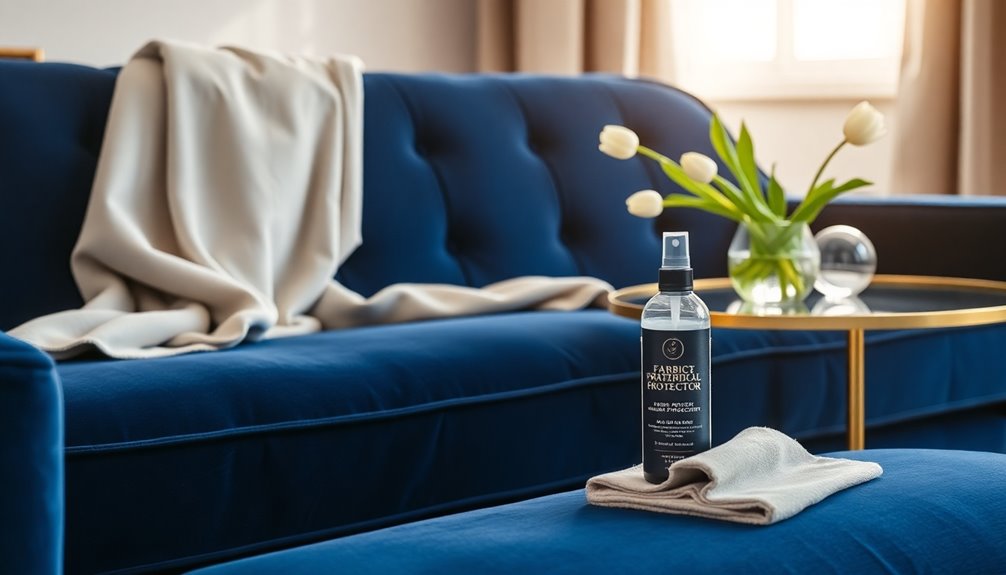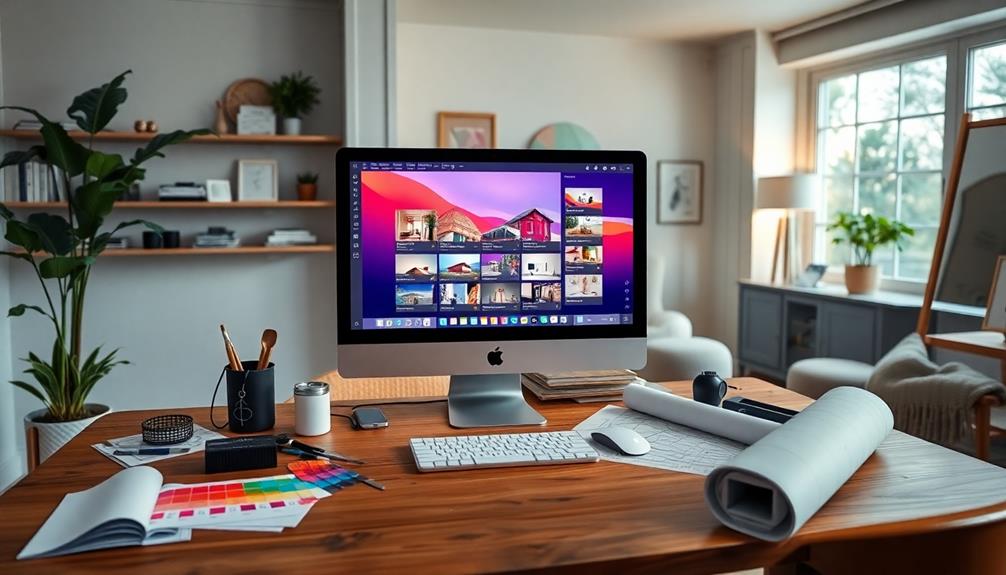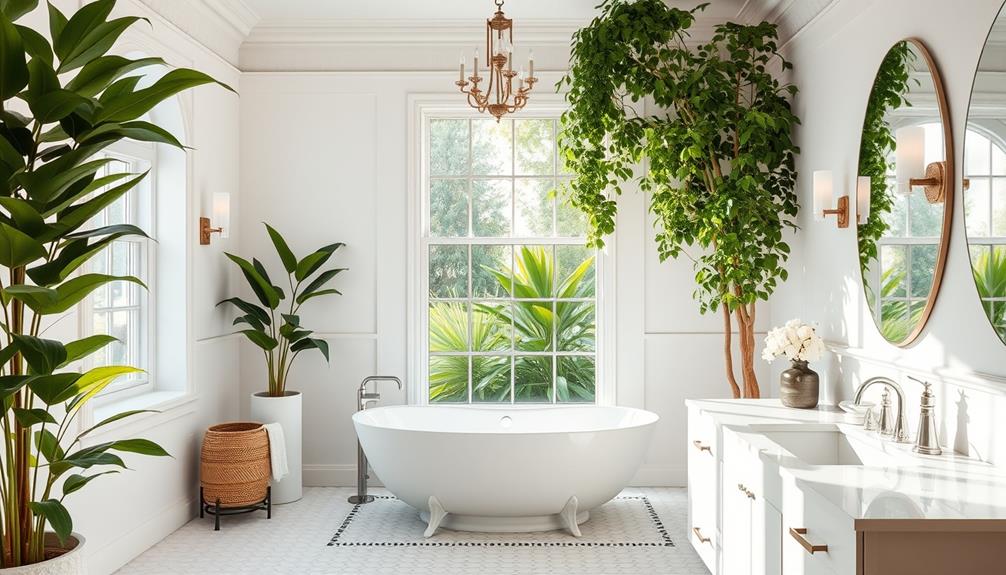To protect your velvet sofa, start with regular maintenance. Vacuum it weekly to remove dust and fluff the cushions to prevent sagging. Use coasters and trays for drinks, and avoid placing food directly on the fabric. Consider applying a fabric protector spray every 6-12 months to enhance stain resistance. Have a stain removal kit handy, including microfiber cloths and soft-bristle brushes for quick clean-ups. Keep the sofa away from direct sunlight and heat sources to prevent fading and distortion. With these tips, your sofa will stay beautiful and inviting; keep exploring for more effective care techniques!
Key Takeaways
- Apply fabric protector sprays every 6-12 months to enhance stain resistance on your velvet sofa.
- Keep the sofa away from direct sunlight and heat sources to prevent fading and fabric distortion.
- Use machine-washable throws as protective barriers against dirt, hair, and spills.
- Implement a no-shoe policy and utilize coasters to minimize dirt and prevent stains.
- Regularly vacuum and fluff cushions to maintain appearance and prevent wear.
Introduction
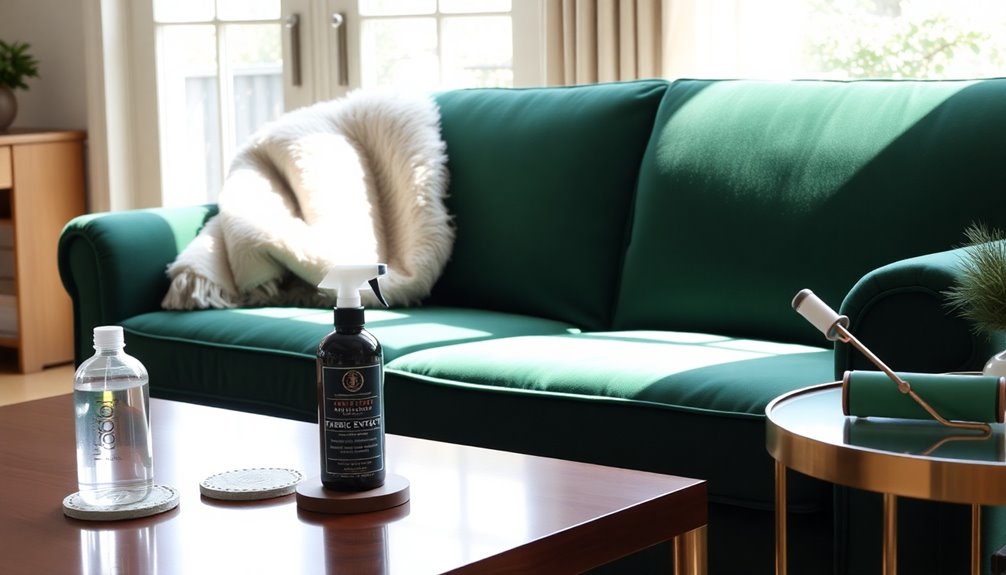
When it comes to keeping your velvet sofa looking its best, regular care is key. You'll want to set aside time for weekly vacuuming, use the right cleaning techniques, and know how to tackle pesky pet stains. By following these steps, you can ensure your sofa stays beautiful and inviting for years to come.
Weekly Vacuuming Sessions
To keep your velvet sofa looking its best, it's crucial to incorporate weekly vacuuming sessions into your cleaning routine. Using a vacuum cleaner with a soft brush attachment, you can effectively remove dust and debris that accumulate in the delicate fibers of velvet. This regular cleaning not only helps preserve your velvet's appearance but also maintains its luxurious feel.
Weekly vacuuming prevents dirt buildup, which can lead to dullness and wear over time. Be sure to pay attention to all crevices and seams. These areas often hide dirt and allergens that can detract from your sofa's beauty and contribute to a less clean living environment.
When vacuuming, keep your vacuum on low power. This reduces the risk of damaging the velvet pile while effectively lifting any trapped particles or pet hair. Incorporating these sessions into your routine can significantly extend the lifespan of your velvet sofa, ensuring it remains fresh and inviting. By dedicating just a little time each week, you can maintain the elegance of your sofa and enjoy its luxurious look for years to come.
Fabric-Specific Cleaning Techniques
Understanding the specific cleaning techniques for different types of velvet is essential for maintaining your sofa's beauty and longevity. Different velvet fabrics, like cotton, silk, and synthetic blends, require tailored approaches. For cotton velvet, you'll want to use a mild upholstery cleaner. When spills occur, immediately blot the area with a dry cloth instead of scrubbing, as this helps prevent stains from setting.
If you have silk velvet, it's best to seek professional care, as this fabric is more delicate. Always test any cleaning solution on a hidden area first to ensure it won't cause discoloration or damage to the fabric.
Regular maintenance is key; use a soft-bristle brush to gently clean the surface in the direction of the nap. This will lift dust and restore your sofa's plush appearance, which is vital for its longevity. Remember, velvet fabric is vulnerable to moisture and staining, so applying the correct cleaning techniques is crucial. By understanding the properties of your velvet, you can effectively care for it and keep it looking stunning for years to come.
Treating Pet Urine Stains
Pet urine stains can occasionally be a nuisance for velvet sofa owners, but quick action can make a significant difference. Start by immediately blotting the stain with a clean, dry cloth to absorb as much liquid as possible. Avoid rubbing, as that can spread the stain and damage the delicate velvet fabric.
Next, mix equal parts white vinegar and distilled water to create a cleaning solution that neutralizes odors and helps lift the stain. Apply this solution sparingly to the affected area, ensuring you don't oversaturate the fabric. After treating the stain, use a clean, damp cloth to blot the area and remove any remaining cleaning solution. Allow the area to air dry completely to prevent moisture damage.
To maintain your velvet sofa, regularly vacuum and brush it to prevent the accumulation of pet hair and dander, which can exacerbate odor issues. Additionally, consider that some pets may have allergies to certain fabrics, which could lead to increased accidents on furniture. Finally, consider applying a fabric protector designed for velvet after cleaning. This can help repel future spills or stains, making cleanup easier. Just remember to test it on an inconspicuous area first to ensure compatibility with your sofa.
Shielding Against Pet Claws
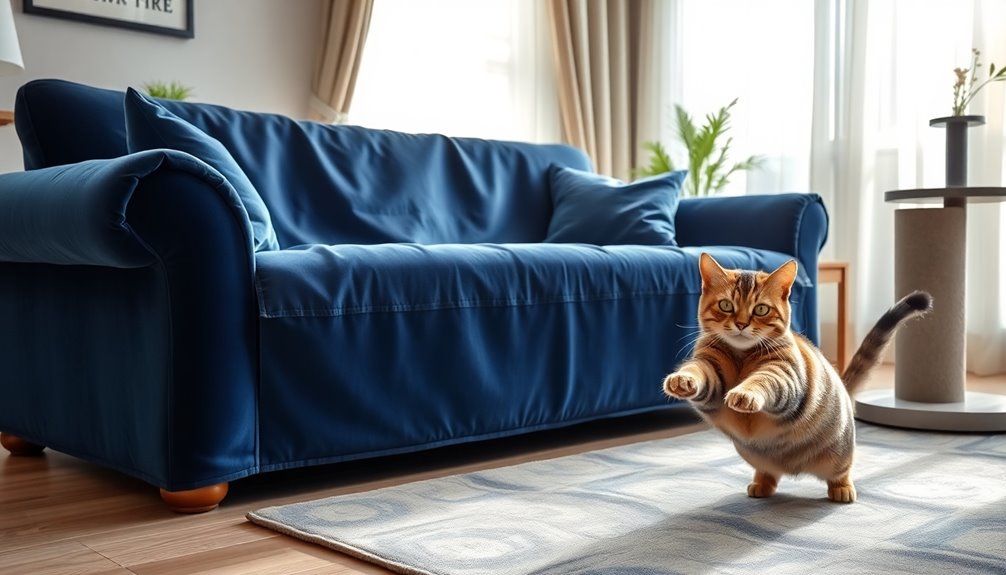
If you've got pets, choosing the right fabric for your sofa is crucial. Opt for paw-friendly materials and consider using machine-washable throws to protect your investment. Additionally, applying protective fabric sprays can help create a barrier against those sharp claws.
Paw-Friendly Fabric Choices
Choosing the right fabric for your velvet sofa is crucial, especially when you have pets that love to jump and play. Opting for synthetic velvet can be a smart move. Unlike natural fibers like cotton or silk, synthetic velvet offers enhanced durability and better resistance to scratches from pet claws. This makes it a great choice for a pet-friendly home.
When selecting your fabric, look for tightly woven velvet. This minimizes the chances of snagging and pulling when your furry friends leap onto the sofa. Additionally, consider velvet blends that incorporate materials like polyester or nylon. These blends not only boost durability but also make cleaning up after accidents much easier.
To keep your sofa looking its best, regularly groom your pets to reduce shedding and fur accumulation. Finally, applying protective sprays designed specifically for velvet can enhance its resistance to stains and claw marks, ensuring your sofa remains beautiful despite your pets' playful antics. By choosing the right fabrics and taking these precautions, you can enjoy a stylish velvet sofa while keeping it safe from your beloved pets.
Opt for Machine-Washable Throws
Opting for machine-washable throws is a smart way to protect your velvet sofa from the wear and tear caused by playful pets. These throws create a protective barrier, preventing pet-related dirt, hair, and scratches from reaching the delicate velvet fabric underneath. When you choose durable materials like polyester or cotton blends, you ensure that the throws can withstand claws and roughhousing.
Textured throws are particularly beneficial since they can help disguise minor wear and tear while adding visual interest to your space. Regular washing is a breeze with machine-washable throws, allowing you to maintain a fresh appearance and eliminate odors that might settle into the velvet. By layering these throws over your sofa, you're not only extending the life of your upholstery but also enhancing comfort for both your pets and family members. Additionally, implementing regular grooming of your pets can significantly reduce the amount of hair that reaches your sofa.
Whether it's a cozy evening or a playful afternoon, machine-washable throws are the perfect solution to keep your velvet sofa looking great while accommodating your furry friends. So, invest in some stylish throws and enjoy a pet-friendly home without sacrificing elegance!
Using Protective Fabric Sprays
Using protective fabric sprays is a highly effective way to safeguard your velvet sofa from the wear and tear that comes with pet ownership. Products like Scotchgard can significantly increase your sofa's resistance to stains and moisture, making it better equipped to handle accidents and pet claws. Before applying any spray, you should always perform a patch test on an inconspicuous area to ensure it won't discolor or damage the fabric.
Regular reapplication of protective fabric sprays is essential, especially in households with active pets, to maintain their effectiveness over time. Always familiarize yourself with the product instructions and proper application techniques to avoid harming your velvet sofa while maximizing protection.
Even with these sprays in place, be proactive in addressing spills and stains immediately. Prompt action minimizes potential damage to the fabric and keeps your sofa looking its best. By combining protective fabric sprays with good cleaning habits, you can enjoy your beautiful velvet sofa without constantly worrying about the impact of your furry friends.
Upholstery Stitching and Seams
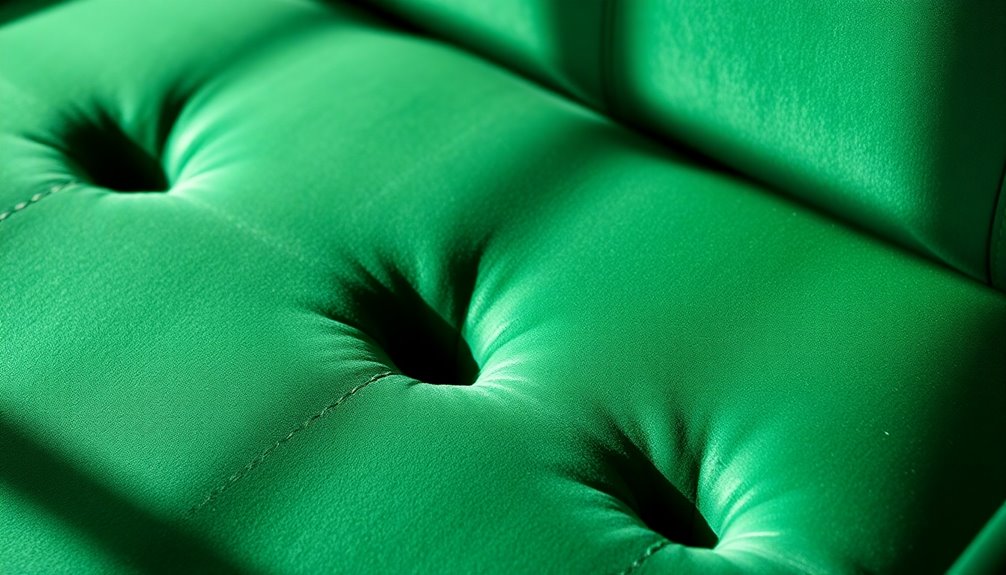
When it comes to your velvet sofa, the stitching and seams play a crucial role in maintaining its structure and appearance. If you don't keep an eye on them, you might face risks like cushion support deterioration or unraveling seams. Regular inspections and timely upholstery repairs can significantly enhance the longevity of your sofa, so don't overlook this important aspect.
Cushion Support Deterioration Risks
To protect your velvet sofa's cushion support, it's crucial to recognize the risks of deterioration that can compromise upholstery stitching and seams. Excessive weight or improper use often leads to weakened stitching and seams over time. To prevent this, regularly plump and rotate your cushions. This practice not only helps maintain their shape but also reduces long-term wrinkles, alleviating stress on the stitching.
Make sure to keep your cushions free from heavy objects to avoid crushing the fibers. This is essential for maintaining the integrity of the upholstery stitching and seams. Investing in high-quality, durable materials for your sofa's internal structure can significantly enhance the longevity of these components, reinforcing their resilience against wear and tear.
Additionally, consider scheduling periodic professional cleaning and maintenance. This can help identify early signs of wear on your upholstery stitching and seams, allowing for timely repairs before they escalate into bigger issues. By being proactive about your velvet sofa's cushion support, you'll ensure that it remains both comfortable and beautiful for years to come.
Upholstery Repair for Longevity
Regular upkeep of your velvet sofa goes beyond just cushion support; it also involves paying attention to upholstery stitching and seams. Regularly inspect these areas for signs of wear or fraying. If you notice any issues, address them promptly to prevent further damage. For DIY repairs, use a needle and thread that matches the fabric color and texture. Ensure your stitching is tight and secure to maintain your sofa's integrity.
In high-use areas like armrests and seat cushions, reinforce vulnerable seams with fabric glue or additional stitching. This precaution can help prevent future wear. It's also essential to maintain proper care by avoiding excessive pressure on seams and following the cleaning process guidelines to prevent fabric strain that could lead to stitching issues. Additionally, investing in home security systems can protect your living space, ensuring your beautiful velvet sofa remains safe from external threats.
If you find seams are significantly damaged or you lack experience, consider employing a professional upholstery service. Their expertise can provide repairs that enhance the longevity of your sofa. By being proactive with upholstery care, you can keep your velvet sofa looking beautiful and functioning well for years to come.
Cushion Fluffing for Longevity
Cushion fluffing is essential for keeping your velvet sofa in top shape and preventing sagging or wrinkles. Regularly fluffing your cushions helps maintain their shape and extends the lifespan of your sofa. To properly fluff, remove the cushions, punch them from all sides, and drop them back into place to restore their original fullness.
While you fluff, take the opportunity to inspect the upholstery seams. Look for any loose threads or signs of wear that may need repair before they worsen. Maintaining cushion fluffiness not only keeps your sofa looking fresh but also preserves the integrity of the upholstery seams. Overstuffed cushions distribute weight evenly, reducing stress on the stitching and preventing future issues.
Aim to fluff your cushions at least once a week. This simple task keeps your velvet sofa inviting and prevents irreversible damage. By staying on top of cushion fluffing, you'll enjoy a beautiful and comfortable seating area for years to come. Remember, a little maintenance goes a long way in ensuring your velvet sofa remains a centerpiece in your home.
Custom Fabric Protectors
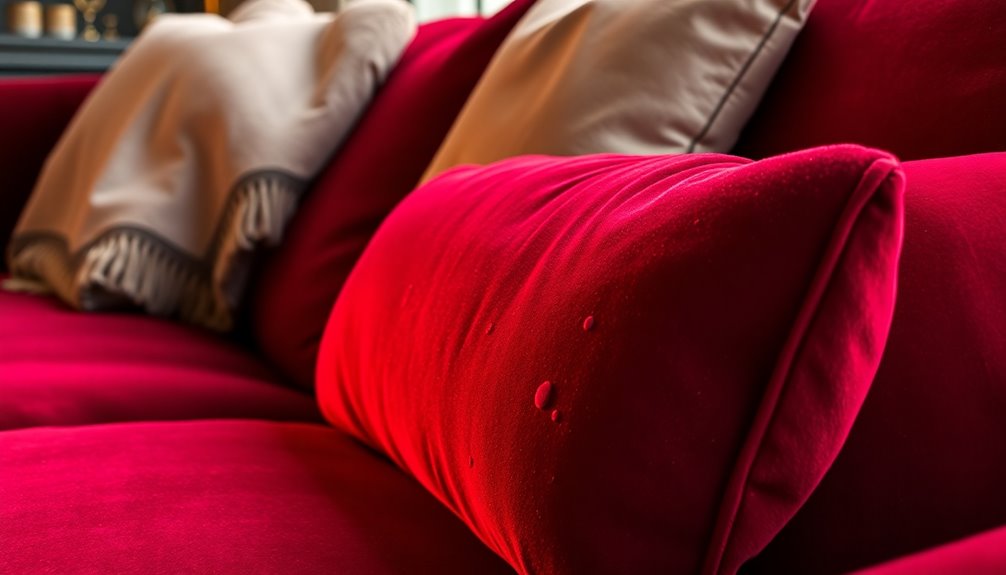
Custom fabric protectors can be a game-changer for your velvet sofa, enhancing its resistance to stains and spills. These protectors create a barrier against moisture and dirt, extending the lifespan of your delicate fabric. To ensure you're using the right product, it's crucial to conduct a patch test on an inconspicuous area before applying it. This step helps you avoid any adverse reactions or discoloration that could ruin the look of your sofa.
Different types of velvet require specific formulations, so look for custom fabric protectors tailored to cotton, polyester, or silk velvet. Regular reapplication is necessary—typically every 6 to 12 months—to maintain effectiveness, keeping your sofa clean and fresh.
You'll be pleased to know that many custom fabric protectors are environmentally friendly and safe for homes with children and pets. This means you can preserve your sofa's aesthetic appeal while enjoying peace of mind. By investing in a quality custom fabric protector, you ensure that your velvet sofa remains a stunning centerpiece in your home, resisting spills and stains like a pro.
Emergency Stain Removal Kit
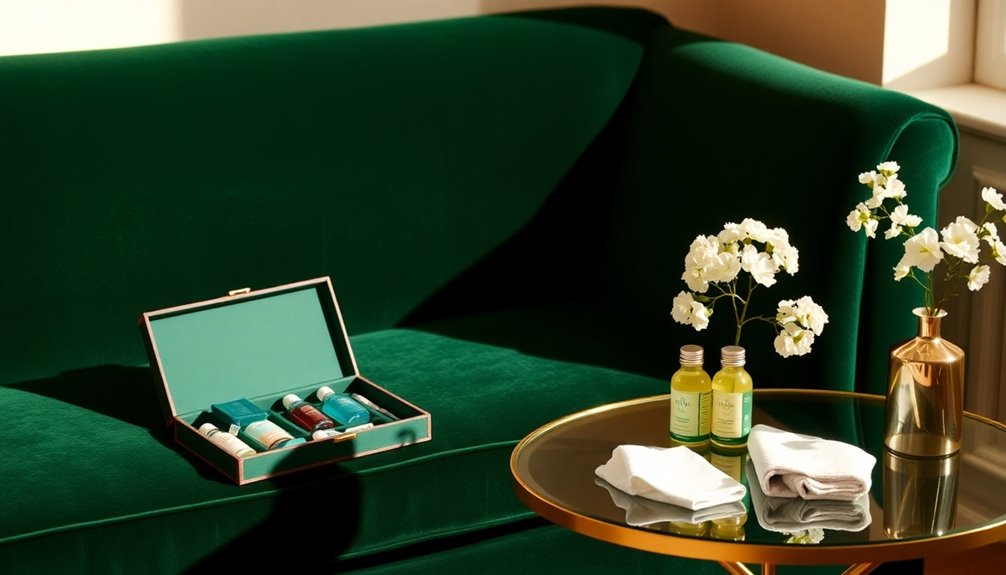
Even with the best fabric protectors, accidents can still happen, making an emergency stain removal kit a smart addition to your velvet sofa care routine. Start by gathering essential items: clean microfiber cloths, a soft-bristle brush, mild dish soap, white vinegar, and distilled water. These supplies will help you tackle spills effectively.
Include a non-abrasive sponge and a spray bottle for easy application of your homemade cleaning solutions. This way, you can address stains promptly and safely. Store the kit in a convenient location, like a living room closet or under the sofa, so it's always accessible when you need it.
Don't forget to regularly check and replenish your supplies, ensuring you have enough cloths and ingredients ready for immediate use. Educate all family members on the use of the kit, emphasizing the importance of proper techniques. Show them how to blot stains gently and test any cleaning solution on inconspicuous areas first.
With this emergency stain removal kit on hand, you'll be better equipped to handle unexpected spills and maintain the beauty of your velvet sofa for years to come.
Conclusion
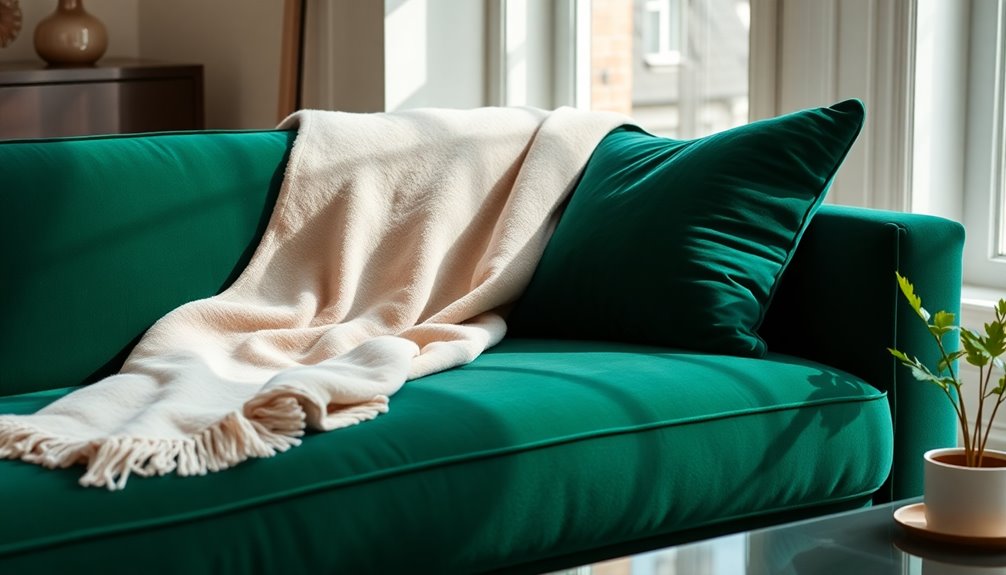
In summary, protecting your velvet sofa requires a combination of preventive measures and prompt responses to spills. Regularly applying protective sprays specifically designed for velvet fabrics can significantly enhance stain resistance and prolong your sofa's life. Additionally, utilizing throws and stylish blankets not only provides a barrier against spills but also elevates your living space's aesthetic.
Engaging your family members, particularly children, in the care routine fosters a sense of responsibility, helping maintain the sofa's condition over time. Remember, scheduling professional cleanings periodically is essential for deep maintenance; this ensures any persistent stains are effectively addressed.
Another crucial step is keeping your sofa away from direct sunlight. This prevents fading and helps maintain its vibrant appearance, especially if you have a darker color. By implementing these strategies, you can ensure your velvet sofa remains a beautiful centerpiece in your home for years to come. Taking these steps will not only preserve its appearance but also enhance your overall comfort and enjoyment. With a little effort and attention, you'll keep your velvet sofa looking its best, making it a cherished part of your living space.
Frequently Asked Questions
How Do You Protect a Velvet Couch?
To protect your velvet couch, start by applying a fabric protector like Scotchgard, but don't forget to test it on a hidden spot first. Use stylish throws to guard against spills, especially during gatherings. Regularly vacuum with a soft brush attachment to keep dust at bay. Avoid placing your couch in direct sunlight to prevent fading, and schedule professional cleaning every so often to maintain its luxurious look and feel.
Does Scotchgard Work on a Velvet Couch?
Yes, Scotchgard can work on a velvet couch, enhancing its stain resistance. Before applying it, you should conduct a patch test on an inconspicuous area to avoid any adverse reactions. Remember, regular reapplication is necessary since the protective layer can wear off over time. Even with Scotchgard, you must address spills immediately to prevent stains, and keep up with regular maintenance like vacuuming to keep your velvet looking its best.
How to Care for a Velvet Sofa?
To care for your velvet sofa, start by vacuuming it weekly with a soft brush attachment to keep dust at bay. When spills happen, blot them immediately with a dry microfiber cloth—don’t rub! Use a velvet brush to restore the fabric’s nap gently. For deeper cleaning, schedule a professional service annually. Lastly, keep it out of direct sunlight to prevent fading and maintain its beautiful appearance for years to come. If you ever need to clean or refresh your sofa’s interior, it’s important to know how to remove a sleeper sofa. This process typically involves carefully dismantling the components so that you can effectively access areas that might collect dust or debris. Once you’ve successfully removed it, take the opportunity to clean the mattress and any hidden surfaces to ensure your sofa stays in top condition.
Can You Waterproof a Velvet Sofa?
You can't fully waterproof a velvet sofa, but you can boost its water resistance. Applying a fabric protector like Scotchgard helps repel spills, but make sure to do a patch test first. If it discolors the fabric, you'll want to reconsider. Remember, regular reapplication of these protectors is key, as their effectiveness fades over time. Always blot spills immediately, since velvet is still vulnerable to water damage despite any protective measures.
